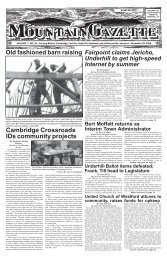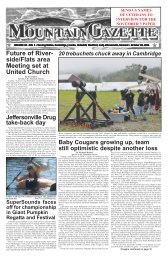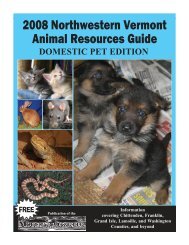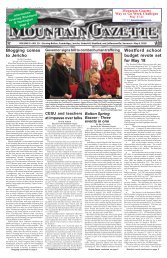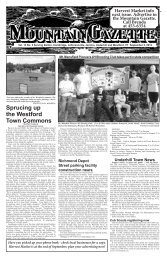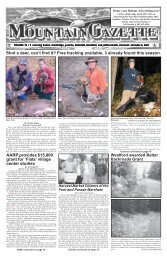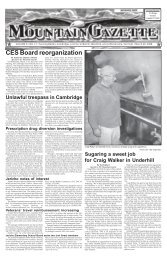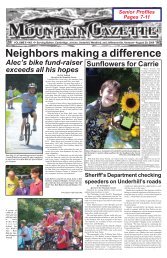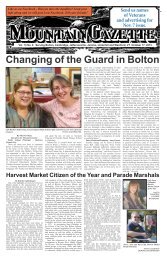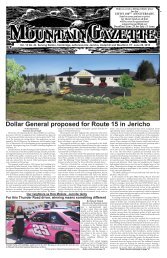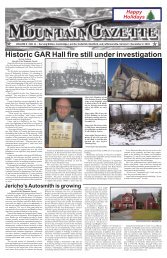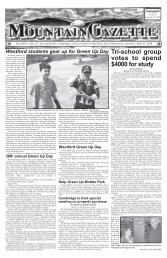Gazette 08-19-10 com.. - Mountain Gazette
Gazette 08-19-10 com.. - Mountain Gazette
Gazette 08-19-10 com.. - Mountain Gazette
Create successful ePaper yourself
Turn your PDF publications into a flip-book with our unique Google optimized e-Paper software.
Page 4 www.mountaingazetteofvermont.<strong>com</strong> <strong>Mountain</strong> <strong>Gazette</strong> • August <strong>19</strong>, 20<strong>10</strong><br />
Ball Games<br />
By Suzanne Kusserow<br />
Senior Guest Columnists<br />
Wow, he can hit anything...or kick....or throw. If a ball is involved<br />
he’s there: a golf ball hiding in the grass, a half-deflated soccer ball, a<br />
tennis ball....and who cares if there’s no net.<br />
The other day he had a piece of flooring, maybe two feet long,<br />
and he batted a ragged, de-furred tennis ball into the far left field of<br />
the meadow, never to be found until frost levels the grass and yellowed<br />
balls will stand out again.<br />
A walnut dropped from a tree is fair game. Even after the cherry<br />
is devoured, the pit be<strong>com</strong>es a spitting game of: “Can I reach the<br />
sink?” Stones need to be skittered down the driveway using good<br />
footwork. And dogs will join in the chase and the fun.<br />
At soccer camp he elected to play goalie - a direct throwback to<br />
his cousin, who’s been a soccer kid loaded with mask, pads and<br />
gloves at the net, for a few years now. Adulation has its advantages.<br />
One time he and I were lolling around on the front lawn - definitely<br />
a day sunny and breezy enough for great lolling. “Let’s play<br />
Frisbee, Gram” he said. “OK” said I. I have thrown a lot of things<br />
in my life: tantrums, pottery, fits, and parties....and have been thrown:<br />
for a loop, a loss, out of line, but mainly from horses. But I have<br />
never thrown a Frisbee. Did I think this was too plebian for a welleducated,<br />
dignified, slightly portly woman? No, dignity has never<br />
been a skill I considered important enough to cultivate. I guess I just<br />
never was part of the hula hoop/Frisbee/jump rope/jitterbug crowd.<br />
So, Will, with his usual skill, neatly sent this dinner plate sailing at<br />
me. (I’m sure the little mischief hurled it way too high!) OK, I need<br />
to toss it back. Hold on to the edge, flip my wrist, fling....and watch<br />
it <strong>com</strong>e drunkenly to rest at my feet. Will fell on the grass, giggling,<br />
snorting and repeating: “Oh, Gram that was awful!” After he recovered<br />
from the hilarious joy of watching his Gramma fail Frisbee <strong>10</strong>1,<br />
he offered to teach me, which was very sweet of him. He gave<br />
detailed instructions, then lessened to simplistic one-word encouragements,<br />
and finally suggested: “Why don’t we play Pick Up<br />
Sticks?”<br />
His Dad is a marvelous golfer and Will now carries a junior set of<br />
clubs and goes with him. That’s the smallest ball he uses and the<br />
range ends at a basketball, which he practices in the basement in the<br />
winter. And winter brings on skiing/snowboarding, following his<br />
Dad and Uncle Karl and Cousin George over any mogul they can<br />
find. And just for plain, no-need-to-practice fun: tube-ing down<br />
Casey’s Hill.<br />
This summer, after watching his sister post and canter, he decided<br />
horseback riding was for him. He goes without stirrups, arms<br />
akimbo, learning how to balance. I watched him as he brought his<br />
fairly sizable horse back to the stable, confidently holding the dangling<br />
reins and paying no concern to lesson #1: “Watch your feet,<br />
because the horse won’t.” Luckily, he made it without incident. He<br />
doesn’t have much fear; a little prudence and caution might well be<br />
learned, but for him fear doesn’t seem to enter his mind. He’s too<br />
busy digging up the lawn and building ramps and jumps for his bike,<br />
and the higher he goes, the better.<br />
So, if you see a blonde kid whose hair is matted with sweat<br />
underneath a battered helmet, slaloming his bike through a lawn<br />
pock-marked with golf, tennis, soccer and foot balls, ask him to<br />
teach you how to play Frisbee. It really is more fun than Pick Up<br />
Sticks. I think I might even try and take some lessons again.<br />
Firewood applications being accepted<br />
Applications are now being accepted for the Firewood Project.<br />
This program was designed to assist in<strong>com</strong>e eligible individuals and<br />
families in Lamoille County. Those receiving wood should be willing<br />
to assist in the transport of their wood. For those who are not<br />
physically unable, volunteers will be available for delivery.<br />
To find out if you are eligible for this program, please call or visit<br />
the Community Action office at <strong>19</strong>7 Harrel Street, 888-7995, or<br />
you may visit the United Way of Lamoille County website at<br />
www.uwlamoille.org and click on “Our United Way” and then “Firewood<br />
Program”.<br />
A wood distribution date has been scheduled for Monday, September<br />
13, 20<strong>10</strong> from 9:00 AM to 3:00 PM. If you are eligible to<br />
receive wood and are physically able, please set aside this date to<br />
pick up your wood.<br />
The Lamoille County Firewood Project is a <strong>com</strong>munity based<br />
project whose goal is to glean and distribute firewood to people in<br />
our <strong>com</strong>munity. We are always in need of volunteers to cut, split,<br />
transport and stack wood as this is an ongoing project. To learn<br />
more about this program, or if you have wood to donate, please call<br />
Dawn at the United Way office, 888-3252. If you are interested in<br />
volunteering for this project, call Dan Noyes at the Volunteer Center,<br />
888-2<strong>19</strong>0.<br />
COMMUNITY COLUMNS<br />
The bottom line on Soil pH<br />
By Duncan McKee<br />
The North Country Gardener<br />
RUNAMOK FARM—August has arrived in the North Country,<br />
although with the weather this summer, we have already enjoyed<br />
a fair helping of dog days already.<br />
It may still seem far away, but this is the time when preparations<br />
for (gasp!) winter should begin. One of these tasks is fertilizing,<br />
which reminded this writer that a subject requested by several readers<br />
had to do with soil acidity.<br />
A pH (potential of Hydrogen) measurement reveals if soil is acidic<br />
or alkaline (also base or basic). If the soil has an equal amount of<br />
acidic and alkaline molecules, the pH is considered neutral. Very<br />
soft water is <strong>com</strong>monly acidic, while very hard water is <strong>com</strong>monly<br />
alkaline, although unusual circumstances can result in exceptions.<br />
The pH scale is runs from 0.0 to 14.0 with 7.0 being neutral.<br />
Readings less than 7.0 indicate acidic soils, while higher readings<br />
indicate alkaline or base soils. Some extreme substances can score<br />
lower than 0 or greater than 14, but most fall within the scale.<br />
While most of the plants that are grown in gardens prefers a soil<br />
pH in the range of 6 -7, there are some plants that thrive well only<br />
in an acidic soil pH. These plants can only grow well and produce<br />
flowers and fruits in acidic soils and are referred to as acid loving<br />
plants.<br />
Some examples of popular acid loving shrubs <strong>com</strong>monly grown<br />
in home landscapes are azaleas, rhododendrons, holly, butterfly<br />
bush, blue hydrangeas, blueberries, and heather.<br />
Some examples of acid loving trees include pin oaks, dogwoods,<br />
and most conifers such as pines, spruce and yews.<br />
These acid loving plants prefers a soil pH of 4 – 5.5 for optimum<br />
growth. The first step is to plant them in soils that are acidic (pH<br />
4.0 -5.5), and to incorporate large quantities of peat or other organic<br />
matter into the soil during soil preparation for planting. If you are<br />
planting in a soil that is high in pH (greater than 6.5 to 7.0) you must<br />
make sure to add acid the soil before planting.<br />
One thing to always remember is that lime should never be applied<br />
to acid loving plants unless the soil test calls for it.<br />
Before planting, soil should be tested and if the soil pH soil is<br />
higher than the optimum range (pH 4.0 to 5.5), it is desirable to<br />
acidify the soil before planting. Over time the soil pH will tend to<br />
increase, especially if the water supply used for irrigation is alkaline.<br />
Elemental sulfur, iron sulfate and aluminum sulfate are soil<br />
amendments that can be used to increase soil acidity.<br />
The growth and appearance of some perennial plants is optimized<br />
by a low soil pH. When the soil pH is greater than desired,<br />
finely ground elemental sulfur is re<strong>com</strong>mended to lower the soil pH.<br />
Keep in mind that a re<strong>com</strong>mendation for sulfur depends on a target<br />
pH and the texture of the soil.<br />
Sulfur reacts slowly with the soil and takes about three to six<br />
months to reduce the pH. Sulfur should be incorporated into the soil<br />
well in advance to planting. Iron sulfate also can be used in lowering<br />
soil pH. Iron sulfate reacts faster than elemental sulfur (in about<br />
three to four weeks), yet it requires 4 to 5 times more material.<br />
In feeding acid-loving plants, as stated, the best option in choosing<br />
the right amount of fertilizer is to do soil testing and follow the<br />
re<strong>com</strong>mendations. Another alternative is to apply a <strong>com</strong>plete fertilizer<br />
like <strong>10</strong>-<strong>10</strong>-<strong>10</strong> once a year in early spring at the rate of one<br />
pound per <strong>10</strong>0 square feet. If your soil is well supplied with phosphorus<br />
and potassium, only nitrogen fertilizer is required. In this<br />
case, choose an acidifying nitrogen fertilizer like ammonium sulfate<br />
and apply at the rate of one pound per <strong>10</strong>0 square feet.<br />
There are some trade-named fertilizers available in the market for<br />
fertilizing acid loving plants. These products should be only used at<br />
re<strong>com</strong>mended rates when required, and remember, DO NOT fertil-<br />
New from the Clutter Barn<br />
The Clutter Barn 20<strong>10</strong> season has flown by and all involved are<br />
giving thanks for another successful summer. The Mission of the<br />
hard-working volunteers is fully realized as each satisfied customer<br />
walks out the door flashing a smile and voicing a “thank you” as<br />
they carry home their treasures.<br />
At the Tag Sale on Saturday, August 28 from 8:00 a.m. to 3:00<br />
p.m., the Clutter Barn’s final Tag Sale this season, the new Christmas<br />
Corner will be opened displaying many ornaments, decorations,<br />
lights and toys that are sure to dress up the holidays in many<br />
homes. Larger items such as tree stands and strings of lights will be<br />
displayed on an outdoor table along with an invitation to visit the<br />
Christmas Corner upstairs in the Clutter Barn.<br />
The Clutter Barn will be open as usual during the Old Fashioned<br />
Harvest Market sponsored by the United Church of Underhill on<br />
September 25 and 26 on the Church grounds and the in park at<br />
Underhill Flats. Now entering its 36 th year, the Market is a source of<br />
entertainment for young and young at heart with always something<br />
new to experience.<br />
Proceeds from the monthly Tag Sales and Harvest Market help<br />
to support the programs and missions of the United Church of<br />
Underhill. Because of the generosity of church members, friends<br />
and folks in the surrounding <strong>com</strong>munities, the Church is better able<br />
offer interesting, educational and fun programs and to reach out to<br />
its members and supporters, as well as to the larger <strong>com</strong>munity, in<br />
fellowship and in need.<br />
The Clutter Barn will continue to accept donations on Saturdays<br />
August 21 and September 11 from 8:30 AM to 12:00 noon, the 11<br />
being the final collection day in order to give the volunteers’ time to<br />
prepare for Harvest Market weekend. The “Barn” will be closed on<br />
September 4, Labor Day weekend. For more information, please<br />
contact Sharon Damkot, tel. 899-3572 or e-mail sdamkot@msn.<strong>com</strong>;<br />
or Betty Wilson, tel. 899-5878 or e-mail<br />
wanderingwilsons2000@yahoo.<strong>com</strong>.<br />
Soil tests are re<strong>com</strong>mended for determining the suitability of soil<br />
amendments and the rate of application. This chart lists amendments<br />
and their uses in adjusting soil pH.<br />
CHART CONTRIBUTED<br />
ize these plants after the beginning of August. Fertilizing after this<br />
time may force growth during winter when the plants should be<br />
dormant.<br />
Acid loving plants need minerals such as iron and manganese in<br />
addition to nitrogen, potassium, and phosphorus. In an acidic soil<br />
the minerals like iron and manganese be<strong>com</strong>e soluble and be<strong>com</strong>e<br />
readily available to plants.<br />
The most <strong>com</strong>mon problem that develops in an acid loving plant<br />
is yellowing of leaves, known as chlorosis. This symptom is often<br />
mistaken for nitrogen deficiency by gardeners, whereas the yellowing<br />
is actually due to an iron deficiency.<br />
The symptoms of iron deficiency appear as yellowing of new<br />
leaves at the tips of the branches, while mature leaves remain dark<br />
green. The veins of chlorotic leaves may be green, and stand out<br />
from the yellowing leaves.<br />
This deficiency can be temporarily corrected by one or two applications<br />
of iron sulfate sprayed on the foliage at the rate of one<br />
ounce per gallon of water. If necessary, a second application may be<br />
made after a couple of weeks. Soil application of one to two pounds<br />
of iron sulfate per <strong>10</strong>0 square feet will have long term effects.<br />
Make sure to mix iron sulfate in the soil and water the plants well<br />
after soil application. Iron chelates also can be used in correcting<br />
iron deficiency by applying at the rate of one ounce per <strong>10</strong>0 gallons<br />
of water and sprinkling over the plants and onto the soil.<br />
In sandy soils, magnesium deficiency can be<strong>com</strong>e a problem with<br />
acid-loving plants. The symptoms appear as interveinal chlorosis<br />
(yellowing) first in older leaves and then moving to younger ones.<br />
The new shoots that form will not look healthy.<br />
Only soil and plant tissue testing can help in identifying this<br />
deficiency, and in correcting the problem. Magnesium deficiency<br />
can be corrected by applying one half cup of magnesium sulfate<br />
(Epsom salts) per <strong>10</strong>0 square feet and by watering well after application.<br />
That said, the gardener who ensures that the soil is properly<br />
amended for the plants he or she is growing, should have great<br />
results and beautiful blooms.<br />
Until next month, keep your tools clean and happy gardening.<br />
Duncan McKee, a.k.a. The North Country Gardener is a longtime<br />
garden writer as well as a Master Gardener and Horticultural<br />
Consultant. If you have questions, you can contact him via e-mail at:<br />
damwrites@gmail.<strong>com</strong>.<br />
Making a sports match<br />
By Dr. Lewis First<br />
With fall almost here, children are out and about and parents<br />
want to enroll their children in all kinds of fall sports activities. In<br />
fact parents will often ask me “how do I know when my child is<br />
ready to try a new sport and what sport is best for my child?” So<br />
this week, let me try to be game enough to discuss when to introduce<br />
your child to a particular team sports activity.<br />
Playing a sport can certainly have its benefits. It can help your<br />
child develop basic motor skills, self-confidence, teamwork, and<br />
sportsmanship. They will also learn how to deal with success and<br />
failure. And, by participating in sports early, they are more likely to<br />
make physical exercise a lifelong habit.<br />
The name of the game in selecting a sport is to match the exercise<br />
activity required to the developmental maturity of the child. You<br />
can’t rush throwing and kicking any more than you can ask a baby<br />
to start walking or talking if they are not yet ready from a motor and<br />
social skills standpoint. Most children aren’t ready for team sports<br />
until they start elementary school, although they can learn skills for<br />
those sports earlier if they have an interest.<br />
Here are some guidelines for making the right choice: The best<br />
sport for a child is the one that the child thinks is fun and interesting.<br />
Spend one-on-one time with your child exposing them casually to<br />
many different athletic activities, and see which ones your<br />
child is interested in. Once they have expressed an interest, choose<br />
a <strong>com</strong>munity athletic program where they will learn the new sport<br />
in a relaxed atmosphere while having fun and getting support and<br />
encouragement from adults. Be patient: it may take a few tries or<br />
seasons to find the right sport, and for your children to figure out<br />
what they, and not you, really enjoy doing. Check with your child’s<br />
doctor as well to make sure there are no medical reasons why your<br />
child should not be playing a sport they like.<br />
Parents also need to watch their child’s behavior and their own<br />
behavior at games and practices. Be an enthusiastic and responsible<br />
spectator if you don’t want to help coach. Make sure your child has<br />
a good coach, not one who yells and screams, or criticizes a youngster<br />
in front of others.<br />
Teach your child that success in sports is more than just winning.<br />
Praise the effort, and not just the performance. A smile or thumbsup<br />
from the sidelines can go a long way toward building a child’s<br />
confidence and self-esteem.<br />
Hopefully, tips like this will be considered winning ones when it<br />
<strong>com</strong>es to helping your child enjoy participating in sports.<br />
Lewis First, M.D., is chief of Pediatrics at Vermont Children’s Hospital<br />
at Fletcher Allen Health Care and chair of the Department of<br />
Pediatrics at the University of Vermont College of Medicine. You can<br />
also catch “First with Kids” weekly on WOKO 98.9FM and on<br />
WCAX-TV Channel 3. Visit the First with Kids video archives at<br />
http://www.FletcherAllen.org/firstwithkids



